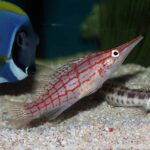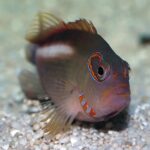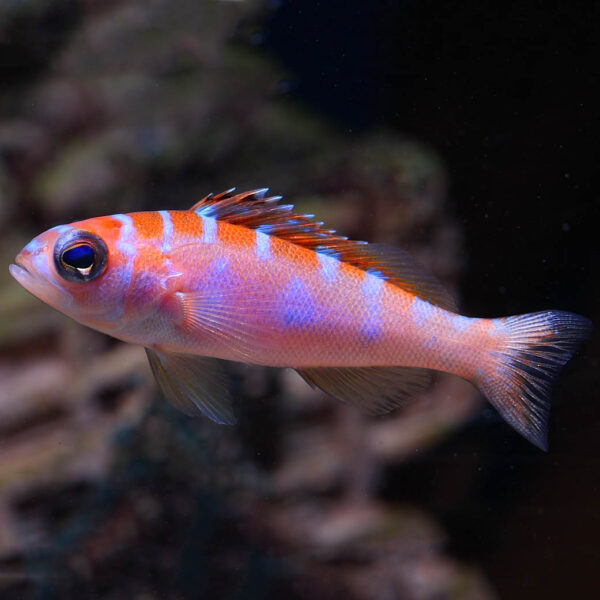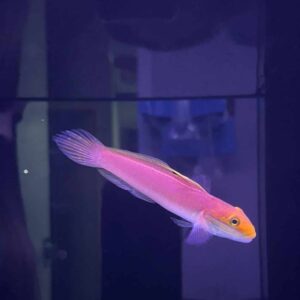Description
Chalk Bass, Serranus tortugarum, are a species of small, brightly coloured fish that are native to the Western Atlantic, primarily in the Caribbean Sea and Gulf of Mexico. They typically grow to a maximum length of around 3 inches (7.5 cm) and have a long, slender body with a relatively large head. Their coloration can vary, but they are generally yellow or orange with bold, dark stripes and characteristic chalky white markings on their head and body.
Natural Habitat: Rocky Reefs and Seagrass Beds
In the wild, Chalk Bass can be found in rocky reefs and seagrass beds, where they live in small groups or pairs. They prefer shallow, clear water with plenty of hiding places and areas to explore.
Keeping Chalk Bass Healthy: Delicate Care Required
Chalk Bass are a bit on the delicate side in terms of care level and are recommended for experienced aquarists. They require a well-maintained aquarium with stable water parameters, including a temperature range between 72 and 78°F (22 to 26°C) and a pH range between 8.1 and 8.4. They prefer a KH range between 8 and 12 dKH.
Special Requirements and Feeding: A Varied Diet is Important
Chalk Bass are carnivorous and require a varied diet that includes live or frozen meaty foods such as brine shrimp, mysis shrimp, and krill. They may also accept high-quality prepared foods such as pellets or flakes. It’s important to offer a variety of foods to ensure they receive all the nutrients they need.
How Many Chalk Bass Should I Keep?
Chalk Bass can be kept alone or in small groups of up to 6 individuals. However, they may become territorial towards members of their own species, so it’s important to provide plenty of hiding places and visual barriers in the aquarium.
Lighting Preference: Moderate Lighting is Ideal
Chalk Bass prefer moderate lighting in the aquarium. They can be kept in reef tanks, but may nip at some types of corals.
Suitable Tank Mates: Non-Aggressive Fish are Ideal
Chalk Bass are generally peaceful and can be kept with other small, non-aggressive fish. However, they may become aggressive towards smaller fish or invertebrates.
Breeding Serranus tortugarum: Possible but Difficult
Breeding Chalk Bass, Serranus tortugarum, in captivity is challenging, but possible with the right conditions and care. These fish are egg-layers and require specific conditions to successfully spawn.
- To start
To begin with, you will need to provide a suitable spawning site in the aquarium. This can be a flat rock, a piece of slate, or a specially designed spawning cone. The site should be located in a quiet area of the aquarium away from any potential disturbances.
You will also need to provide a high-quality diet to ensure the fish are in optimal breeding condition. Feeding a varied diet of live or frozen meaty foods, such as brine shrimp, mysis shrimp, and krill, will help ensure that the fish are getting all the nutrients they need to prepare for breeding.
- courtship
Once the fish are in optimal condition, you may notice that the males become more territorial and start to court the females. During the courtship process, the male will chase the female around the spawning site, performing a series of displays to attract her attention.
- Spawning and fertilisation
When the female is ready to lay her eggs, she will swim over the spawning site and release a batch of eggs, which the male will then fertilize. This process may be repeated several times over the course of several days, with the female laying several batches of eggs.
After the eggs are fertilized, they will hatch into larvae within a few days. The larvae are very small and require specific conditions to survive, including a well-maintained aquarium with stable water parameters and plenty of food.
Breeding Chalk Bass in captivity can be a rewarding experience for experienced aquarists, but it is important to note that it is a challenging process that requires specific conditions and care.
Sexual Dimorphism: Differences Between Males and Females
There are no significant visual differences between male and female Chalk Bass.
Distribution: Native to the Western Atlantic
Chalk Bass are native to the Western Atlantic, primarily in the Caribbean Sea and Gulf of Mexico. They are not naturally occurring in other parts of the world, but may be imported for the aquarium trade.
Summary: A Delicate and Colourful Species
In summary, Chalk Bass, Serranus tortugarum, are a small, colourful species of fish that are recommended for experienced aquarists due to their delicate care requirements. They prefer stable water parameters and a varied diet that includes live or frozen meaty foods. They can be kept in small groups or alone, but may become territorial towards members of their own species. Chalk Bass are native to the Western Atlantic and are known for their vibrant coloration and characteristic chalky white markings.
The Fish pictured here are representative only and the livestock you receive may vary in pattern, coloration, and shape.









Reviews
There are no reviews yet.